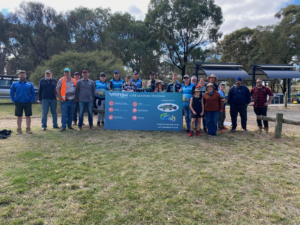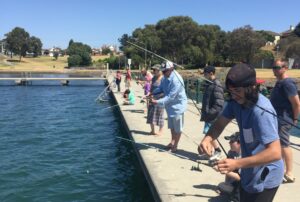June 28, 2021
Written by the Victorian Environmental Water Holder (VEWH)
Carp are the rabbits of our waterways and occupy a wide range of aquatic habitats, including rivers, estuaries, wetlands, lakes, reservoirs, and irrigation networks. While they live in all types of habitats, they are especially visible in shallow water, where they sometimes aggregate in large numbers to spawn. They are a destructive pest and detrimental to our waterways and our native fish populations. Their impacts can be frustrating to managers and communities tasked with restoring fish populations, but they remain difficult to control in many areas.
Since the late 1960s, carp have spread throughout the south-east of Australia, and some parts of Tasmania and Western Australia. Carp can form up to 90% of the fish biomass (i.e. the total weight of fish in an area). When carp exceed 80–120 kg/ha there are major impacts to the environment, including damage to aquatic plants, invertebrates, water quality, native fish and social amenity.
While control efforts for carp continue to develop, one important thing we can do is strengthen our native fish populations, which in turn can place more pressure on carp. To restore native fish, environmental flows (or ‘water for the environment’) are routinely implemented in rivers and wetlands. Together with many other efforts, water for the environment allocations are important in helping rehabilitate aquatic ecosystems, including in the Murray–Darling Basin (MDB). Environmental flows help our native fish in multiple ways – from spawning, recruitment and growth, to maintaining their aquatic habitats and connectivity.
Depending on how wet the environment is, there can be over 360 million carp in Australia. Research has shown that this carp population is governed by large natural floods. Small scale flooding and high flows can result in carp breeding on a local scale, however this makes minimal tangible contribution to the greater population size. As such it is no surprise that, given the prevailing drought conditions in south eastern Australia over the past 20 years, that carp numbers are reducing.
Although the risk of carp breeding has important implications for environmental flows, this risk should always be tempered by the potential for optimising native fish outcomes, and the fact that it is large natural flooding which controls how many carp are in our rivers. Therefore, managing environmental flows to maximise the greater relative benefits for native fish while minimising carp risks is a guiding principle for river managers.
Fortunately, our understanding of carp ecology, distribution, abundance, impacts and control continues to improve. This knowledge can help managers choose the best approaches to reduce carp impacts. For example, at Lock 1 on the lower Murray River, weir keepers use a specially designed ‘carp jumping cage’ to trap carp as they move through fishways and have automatically removed over 720 tonnes over an 11-year period. At Moira Lake, in the central Murray, commercial fishers remove up to 76 tonnes of carp annually to stop them getting back into rivers.
All this knowledge can help improve the management of risks relating to carp reproduction and flows. We need to implement and prioritise adequate management actions to control carp where there are high-risk watering activities and sites such as large wetlands and floodplain areas.
So, what’s the bottom line? Environmental flows are a key tool in restoring our native fish populations; their benefits far outweigh the impacts of small increases of carp numbers in some circumstances.
For more information on water for the environment, visit the Victorian Environmental Water Holder’s website.








